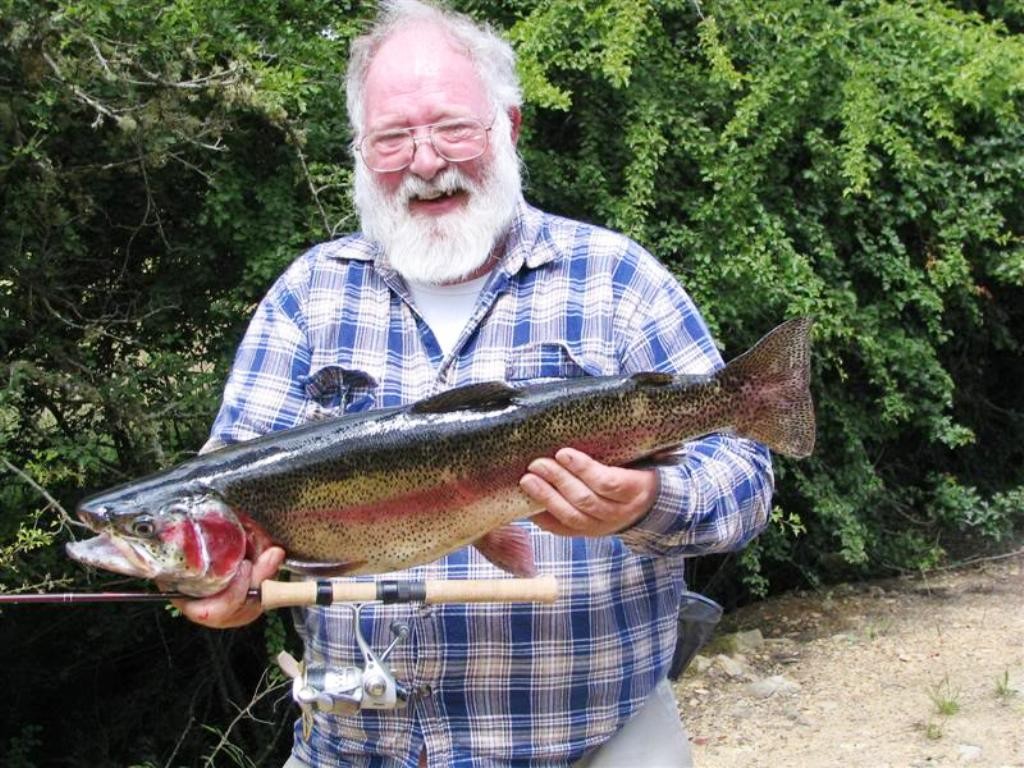North and South Esk Tasmania
by Carl Hyland on 2 Oct 2012

A big rainbow from St Pats. (Mountain Stream Fishery). Carl Hyland
'Tasmania’s life flow is carried by these magnificent little waterways. Most of these little creeks you could step over, or pass by without sampling some of the great little trout that lie within. Usually these smaller creeks are tributaries of bigger streams.'
The North Esk River is but one river in Northern Tasmania. It is one of the tributaries of the Tamar River together with the South Esk River. It starts in the Northallerton Valley below Ben Nevis in the states north East joining with the St Patricks River, flowing through Launceston. Launceston's Old Seaport tourist feature is located on the North Esk River. The river becomes tidal downstream of Hoblers Bridge to where it meets the Tamar. It is sometimes subject to flooding, especially in East Launceston suburbs.
The famous Australian beer factory Boags draws its water from St Patricks River and a good drop it is too!
The largest tributary of the North Esk is the St Patricks River, with others including the Ford River which flows from the ski fields of Ben Lomond and downstream of the Corra Linn Gorge, the Roses Rivulet and Distillery Creek.
Tasmania’s life flow is carried by these magnificent little waterways. Most of these little creeks you could step over, or pass by without sampling some of the great little trout that lie within. Usually these smaller creeks are tributaries of bigger streams. Hundreds of kilometers of small creeks, house thousands of trout. These creeks fish well on any sort of day, from the start of the season until the end.
These creeks are up in the headwaters and valleys of the many mountains. They are side waters and tributaries of the main rivers, and with a cup of tea and a decent map you will soon pick out a few waterways worthy of closer inspection. If they have water running in them, then it is plausible that they will have plenty of trout. The trout are almost always browns, and will be totally wild fish. Up until recently, the Tasmanian Inland Fisheries Service doesn’t stock Tasmanian Rivers, so healthy were the many populations of wild brood stock.
The top reaches of the North Esk River above Blessington are a stream angler’s delight. The road out of Launceston towards St Leonards and past White Hills will open up a huge expanse of trout water. The North Esk shrinks into a delightful stream, with deep pools and magnificent fast flowing pools. The majority lie within state forest, so access isn't a problem. It is very easy to lose track of time up in this beautiful environment, as you sneak between pools and runs, casting lures or tossing flies gently upstream.
The top end of the South Esk is also a mecca for anglers and fish and again, rarely does it receive much in the way of attention.
Again, these tributaries are full of fish, not big fish, but you will get your bag. A surprise can sometimes be the odd lunker and a bonus is the fact you probably won’t see another soul all day!
The South Esk River is the longest river in Tasmania. It starts in the mountains near Fingal flowing through Avoca, Evandale, Longford, Hadspen and finally Launceston. The river is dammed at Trevallyn Dam near Launceston and used for the city's Hydro Electricity scheme. Although most of the water is dammed at Lake Trevallyn, some flows on into the Cataract Gorge where it becomes a tributary to the Tamar River, and the outflow from the power station also joins the Tamar River downstream of Launceston. The river is constantly subject to flooding and overflows at Lake Trevallyn cause a scenic display of rapids gushing through the Gorge.
The river's two largest tributaries are the Macquarie River and the Meander River, with lesser tributaries being the Nile River, River Tyne, Stories Creek and the Break O'Day River upstream of the junction with the Macquarie River. The Meander River's main tributaries are the Liffey River and Quamby Brook and the Macquarie River's main tributaries are the Lake River, Isis River, Elizabeth River, Blackman River, Tooms River and Tin Dish Rivulet.
Other catchments run off the northern and northwestern side of the Western Tiers – careful exploration is well worthwhile. For example the Liffey River runs from its junction with the South Esk near Carrick all the way to the central plateau – and fish in it the whole distance.
If you want to link to this article then please use this URL: www.sail-world.com/102488